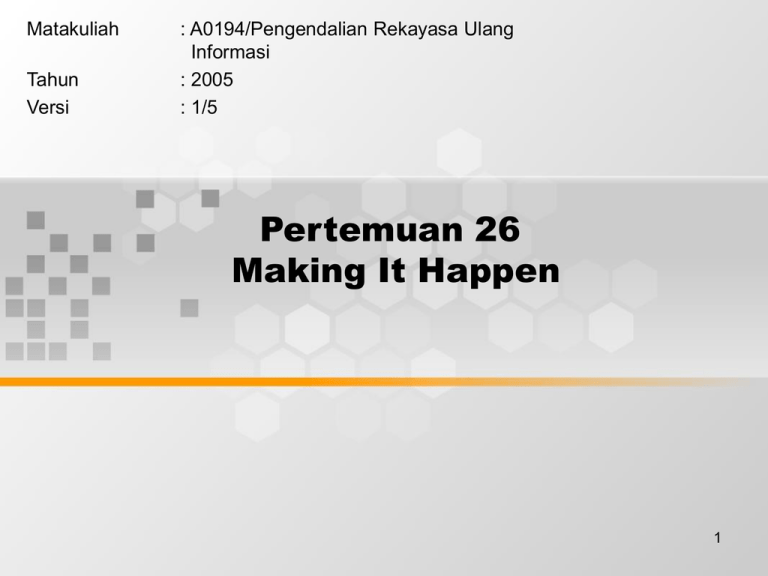Pertemuan 26 Making It Happen Matakuliah : A0194/Pengendalian Rekayasa Ulang
advertisement

Matakuliah Tahun Versi : A0194/Pengendalian Rekayasa Ulang Informasi : 2005 : 1/5 Pertemuan 26 Making It Happen 1 Learning Outcomes Pada akhir pertemuan ini, diharapkan mahasiswa akan mampu : • Menunjukkan hubungan antara kebutuhan kontrol dengan current architecture 2 Outline Materi • Warehouse and Decision Support System as Interim Integrators • The reasons for The Split of Operational and Information Database • Benefit of Warehouses • Managing The Architecture • There You Have IT! 3 Warehouse and Decision Support System as Interim Integrators Data warehouse is a database that provides users with data, extracted from production and online transaction processing system, that supports analysis activities. 4 Warehouse and Decision Support System as Interim Integrators The source of data for data warehouse is the operational architecture. 5 Warehouse and Decision Support System as Interim Integrators The data in operational types of database is structured for transaction processing, not for data search and retrieval. 6 Warehouse and Decision Support System as Interim Integrators A decision support architecture is made up of a set of data warehouse and software tools that analyze data held in warehouse. 7 Warehouse and Decision Support System as Interim Integrators Operational database, online analytical processing (OLAP) is software characteristic used in the decision support environment against data warehouse. 8 The reasons for The Split of Operational and Information Database • The data serving operational needs are physically different data from those serving information or analytical needs. • The supporting technology for operational processing is fundamentally different from the technology used to support informational or analytical needs. • The user community of operational data is different from the one served by informational or analytical data. • The processing characteristics for the operational environment and the informational environment are fundamentally different. 9 Benefit of Warehouses To meet the needs of management. The information in the warehouse allows managers to make better decisions. Raises the visibility of significant problems in the operational architecture. Buffer you from some of data quality and compatibility problems in the legacy operational architecture. Create data model without considering the legacy environment. (this is a good place to create the enterprise data model and identify data standards.) 10 Managing The Architecture • Requires some sort of central control. • Places the definition and management of the business views of the architecture centrally. • Allows central authority with centralized deployment, a true balance of power in enterprise. 11 There You Have IT! • Designing and implementing a streamlined, integrated information architecture is not so difficult. • First, define systems boundaries based on classification theory so that each information system has the fewest possible tentacles into other information system. • Then, design a technology architecture that links these information systems using hubs to minimize the number of links even further. 12 The End 13



